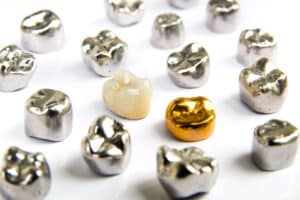The price we pay for beauty is enormous, and the price we pay to fix beauty mistakes can be even more if we are not careful! Oral adornments, like teeth gems, lip piercings, or tongue piercings can be enticing, but it is not without its risks. Examining the history of dental gems and piercings, we address questions and precautions from a dental perspective.
History of Teeth Gems and Oral Piercings
Decorating teeth with gems and oral piercings has been around for centuries. There are historical records indicating that cultures from ancient times, such as the Mayans, used dental embellishments as status symbols or spiritual purposes. It was not until the mid to late 20th century that the fashion statement began to reemerge. As societal values evolved and personal expression gained broader acceptance, various forms of piercings, including those worn by celebrities, high schoolers, and individuals associated with a rebellious style, became increasingly common.
Although, many traditional values still exist today that criticize the practice of body modification such as this or tattoos. Self-expression in the 21st century is more welcomed than ever before. Most employers and some parents allow tattoos, piercings, and unique hair color unlike back in the day. This can also be credited to the advancements in dental care as it transformed from basic hygienic needs to full-smile makeovers, improved dental aesthetics, and more options for smile enhancement.
Oral piercings and tooth gems have fascinated individuals in pursuit of distinctive self-expression. From ancient rituals to modern fashion statements, these practices persistently captivate, embodying the innate human inclination to personalize one’s distinct appearance.
Complications with Tooth Gems
All that glitters is not gold. There are some dental clinics that offer rhinestones (teeth strass), but more than likely these tooth gems are offered somewhere other than your local dental office. We see a lot of specialty spas or facial aesthetics services that include tooth gem kits on their menus. Before moving forward with the service, ask about their sterilization techniques. If you do not see tools in sterile bags or they don’t use gloves, it wouldn’t be a good idea to move forward.
- Dangerous Adhesives – Some individuals might experience discomfort or irritation due to the presence of the tooth gem. This is likely from the type of adhesive used during application. Medical grade adhesives are the safest form of adhesive to use in your mouth. This may include glass ionomer or dental-grade resin. Super glue, polyurethane based glue, and rubber glue products are harmful to the teeth, gums, and skin of the oral cavity. Be sure to ask what ingredients are in the type of glue used to place the gems on your teeth.
- Oral Health Concern – Poor oral hygiene practices around the tooth gem area could lead to dental health issues such as tooth decay or gum problems. Plaque loves uneven surfaces, making it close to impossible to clean around rhinestones or diamonds glued to the tooth. This can inhibit harmful tooth decay and negatively impact your oral health.
- Potential for Damaged Teeth – In some cases, incorrect application or removal of the tooth gem could lead to enamel damage or tooth chipping. And with the type of adhesive, it is more likely if it is not a medical-grade adhesive because it will be much more abrasive.
- Longevity – Tooth gems will not last indefinitely. They are not made to until they are drilled into your tooth and placed by a professional. Even then, there are no guarantees of long-term wearability.
Complications with Oral Piercings
Tooth trauma can be a high likelihood with metal in your mouth. Other concerns would be chipped teeth, cracks, and infections are also concerning with tongue piercings and lip piercings. Here are other concerns your dentist may have:
- Infection – One of the most common problems with oral piercings is the risk of infection. The mouth is full of good and bad bacteria. Bad bacteria paired with an infection will likely result in pain and a visit to the dentist. It is crucial to follow aftercare guidelines and to maintain good oral hygiene to reduce this risk.
- Tooth Damage – Metal jewelry can potentially chip or crack your teeth. Tooth damage is not only painful, but repairing it can be costly and complicated. Repairing a cracked tooth with a dental crown can easily cost $1200! And, depending on its severity, it could mean complete tooth extraction and tooth replacement options like dental implant or partials.
- Allergic Reactions – Some people might experience allergic reactions to the metal used in jewelry such as nickel. This can cause irritation, discomfort, and may encourage you to take it out.
- Difficulty with Oral Care – Oral piercings can make it challenging to take care of your mouth properly. They can be hard to clean around making you more susceptible to issues like cavities.
Celebrities with Piercings they Removed
Fergie: The singer Fergie, known for her time with the Black-Eyed Peas, had a tongue piercing that led to complications and damage to her teeth.
Kaley Cuoco: Actress Kaley Cuoco, famous for her role in “The Big Bang Theory,” experienced issues with her tongue piercing. She revealed that the piercing chipped her tooth and caused discomfort, leading her to eventually remove it.
Ke$ha: Musician Ke$ha has been open about her various body piercings, including oral piercings. She shared that she had her tongue pierced, but later regretted it due to difficulties with singing and potential risks.
Conclusion
From ancient traditions to modern day glimmer. It is valid to recognize the potential challenges they pose. As we embrace personal style, remember the importance of responsible practices and maintaining dental well-being. Style should not trump oral health, as it can be a high-risk choice that can lead to costly treatment or repairs if complications arise.
_
Disclaimer: Respecting Individual Expression and Oral Health
At Hale Family Dentistry, we deeply respect each person’s right to self-expression. This article is intended not to diminish individual styles or choices, but to offer professional insight into the dental implications associated with oral piercings and tooth jewels. Our focus, from a dentist’s perspective, is to inform about the potential impact these choices can have on oral health.
It is a fundamental principle at our practice that everyone is treated with the utmost respect and care, regardless of their personal style or self-expression. We are committed to providing a welcoming, judgment-free environment. Our team practices a policy of non-discrimination and inclusivity, ensuring that all patients feel comfortable and valued when they visit our office.


